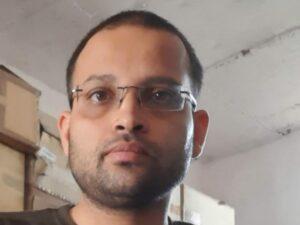Amandeep Vashisth
[Part one]
[ A discussion took place among : myself, Dr Swati Goel and Sh. Laxmi Narayan Tiwari ji regarding a typical problem. The problem was regarding the choice of sources. We all know that Persian sources prevail amongst primary sources for reconstruction of medieval history. Then, how do we place Braj (language) sources in this frame of reference of history. Do Braj sources really provide a plank for any paradigm shift ,or say , if not a paradigm shift (as that term may be too pretentious at this stage) then, may be at least a re-configuring of available frame. This write up is a compilation of tentative thoughts that arose as a response to that discussion.]
one :
Vernacular proposes two dimensions: One, it emerges out of the ‘field’ [ Field as the ground inherent in ‘field studies’] . Second, it lacks canonisation.
Vernacular is fluid in nature.
Braj stands at crossroads.
{A cliché – The classicism inherent in ‘Pingala format’ and its contrast with ‘Dingala’, the breathtaking symmetry of linguistic architecture of Braj Bhasha, prevents one from labelling Braj linguistic frame as – vernacular!}
two :
Braj, by and large, is a representative of ‘Sagun Bhakti’ poetry. The dichotomy of ‘Sagun’ and ‘Nirgun’ prevalent in modern academic discourse finds itself titled towards ‘Nirgun’ when we place ourselves along-with Persian sources. This tilt occurs due to a shared epistemic space between ‘Nirgun’ and ‘persian’.
Hence ‘Sagun’ emerges as pompous and exuberant [often ascribed with a slant parallel to Lacanian ‘Jouissance’]
three :
Persian source seems to be internally stable and emotionally-neutral. Though one can’t claim complete neutrality as per Foucauldian ‘archaeology of knowledge’. Albeit, this ‘neutrality’ is relatively more pronounced due to following factors:
a) Persian has a tradition of its own written-prosaic ‘Tawarikh’. On the contrary, Braj lacks any prosaic-corpus except semi-fluid Vartta literature which is more in line with orality of Indian tradition expressed via prose instead of metrical verse.
b) Sometimes ,when a plain fact is expressed via verse , one wonders the actual significance of medium. See-
मदनमुहन के पास दुसइति, सो गौराइदि बाजै।
भुमिया जिमीदार मुकदम सब, ताके मध्य विराजैं।।
[Vrindavan-Dhamanuragavali 7.28]
This plain piece of information travels through verse. How does verse affect the nature of information. Is it just another case of empty ornamentation, rendered null and void by the very metrical structure . Or the verse shapes our perspective !
Compare this with a long exhaustive [exhausting as well!] list of Persian sources which are highly sophisticated in their presentation of past.
four :
Marginal position of prose in the linguistic frame of Braj is not just another case of literary choice. There sems to be ‘something’ in the very nature of Braj to favour metrical elements. The evasion of prose is linked with the shaping of aesthetic-philosophical elements during evolution of Bhakti tradition in the region. [ Recently, one of the renowned scholars wrote a commentary on the celebrated Kelimaal, which is evidently metrical. I wonder if this is a coincidence!]
five :
Though we do differentiate between oriental and occidental perspectives and may be epistemologies thereof [ via Said-ian orientalism] ,but at the same time western canon prevails. This is not a value judgement but rather a plain fact. [Personally I prefer ‘modern’ instead of ‘western’, as methodologies of medieval logicians-saints-philosophers of the west itself have been deserted. Enlightenment rationality has triggered an ‘epistemological break’(borrowing an Althusserian term) within western tradition]
Terms such as – ‘sacred geography’ produce a tantalising effect without articulating the exact shift ! I feel that the shift is nothing but sliding towards western canon.
What is the difference between the methodology of Vividhteerthkalpa and modern texts on sacred geography? If the oriental methodology lacks ‘rigour’ and is rendered incapable of replication during contemporary times, then it becomes evident that a ‘rupture’ has already taken place.
Persian lies within the structure of ‘orient’ but at the same time is endowed with access to statecraft and imperial majesty. Braj linguistic frame contains an amplified degree of social and cultural history[histories] than political.
Braj is reconstruction of – ‘memory’ – with its labyrinthine alleys of subconscious and sometimes ‘out of joint’ with structured-rationality.

(This article has been written by Amandeep Vashishth for historypandit dotcom. Aman lives in Rohtak, Haryana. Aman is a teacher by profession and a scholar of the history and culture of Braj.)



